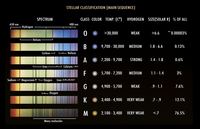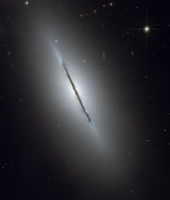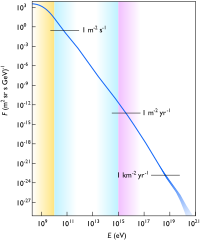
The role of stellar radial motions in shaping galaxy surface brightness profiles
Sign Up to like & getrecommendations! Published in 2017 at "Astronomy and Astrophysics"
DOI: 10.1051/0004-6361/201731485
Abstract: Aims. The physics driving features such as breaks observed in galaxy surface brightness (SB) profiles remains contentious. Here, we assess the importance of stellar radial motions in shaping their characteristics. Methods. We use the simulated… read more here.
Keywords: brightness profiles; stellar radial; surface brightness; redistribution ... See more keywords

Signatures of quenching in dwarf galaxies in local galaxy clusters
Sign Up to like & getrecommendations! Published in 2021 at "Astronomy and Astrophysics"
DOI: 10.1051/0004-6361/202039408
Abstract: The transformation of late-type galaxies has been suggested as the origin of early-type dwarf galaxies in galaxy clusters. Venhola et al. analysed correlations between colour and surface brightness for galaxies in the Fornax cluster binned… read more here.
Keywords: surface brightness; galaxy clusters; type galaxies; cluster ... See more keywords

The surface brightness–colour relations based on eclipsing binary stars and calibrated with Gaia EDR3
Sign Up to like & getrecommendations! Published in 2021 at "Astronomy and Astrophysics"
DOI: 10.1051/0004-6361/202140571
Abstract: Aims. The surface brightness – colour relation (SBCR) is a basic tool in establishing precise and accurate distances within the Local Group. Detached eclipsing binary stars with accurately determined radii and trigonometric parallaxes allow for… read more here.
Keywords: eclipsing binary; colour relations; binary stars; surface brightness ... See more keywords

An expanded catalogue of low surface brightness galaxies in the Coma cluster using Subaru/Suprime-Cam
Sign Up to like & getrecommendations! Published in 2020 at "Monthly Notices of the Royal Astronomical Society"
DOI: 10.1093/mnras/staa1763
Abstract: We present a catalogue of low surface brightness (LSB) galaxies in the Coma cluster obtained from deep Subaru/Suprime-Cam V and R-band imaging data within a region of $\sim$4 deg$^2$. We increase the number of LSB… read more here.
Keywords: lsb galaxies; cluster; coma cluster; surface brightness ... See more keywords

2D surface brightness modelling of large 2MASS galaxies – I: photometry and structural parameters
Sign Up to like & getrecommendations! Published in 2021 at "Monthly Notices of the Royal Astronomical Society"
DOI: 10.1093/mnras/stab2321
Abstract: We have studied a sample of 101 bright 2MASS galaxies from the Large Galaxy Atlas (LGA), whose morphologies span from early to late types. We have generated estimates for structural parameters through a two-dimensional surface… read more here.
Keywords: structural parameters; surface brightness; brightness modelling; 2mass galaxies ... See more keywords

Observational insights on the origin of giant low surface brightness galaxies
Sign Up to like & getrecommendations! Published in 2021 at "Monthly Notices of the Royal Astronomical Society"
DOI: 10.1093/mnras/stab374
Abstract: Giant low surface brightness galaxies (gLSBGs) with dynamically cold stellar discs reaching the radius of 130 kpc challenge currently considered galaxy formation mechanisms. We analyse new deep long-slit optical spectroscopic observations, archival optical images, and published… read more here.
Keywords: surface; brightness galaxies; giant low; surface brightness ... See more keywords

Identification of tidal features in deep optical galaxy images with Convolutional Neural Networks
Sign Up to like & getrecommendations! Published in 2023 at "Monthly Notices of the Royal Astronomical Society"
DOI: 10.1093/mnras/stad750
Abstract: Interactions between galaxies leave distinguishable imprints in the form of tidal features which hold important clues about their mass assembly. Unfortunately, these structures are difficult to detect because they are low surface brightness features so… read more here.
Keywords: identification tidal; features deep; convolutional neural; tidal features ... See more keywords

Studying the ICM in clusters of galaxies via surface brightness fluctuations of the cosmic X-ray background
Sign Up to like & getrecommendations! Published in 2018 at "Monthly Notices of the Royal Astronomical Society"
DOI: 10.1093/mnras/stx2581
Abstract: We study the surface brightness fluctuations of the cosmic X-ray background (CXB) using Chandra data of XBOOTES. After masking out resolved sources we compute the power spectrum of fluctuations of the unresolved CXB for angular… read more here.
Keywords: ray background; cosmic ray; spectrum; brightness fluctuations ... See more keywords

Identification of low surface brightness tidal features in galaxies using convolutional neural networks
Sign Up to like & getrecommendations! Published in 2018 at "Monthly Notices of the Royal Astronomical Society"
DOI: 10.1093/mnras/sty3232
Abstract: Faint tidal features around galaxies record their merger and interaction histories over cosmic time. Due to their low surface brightnesses and complex morphologies, existing automated methods struggle to detect such features and most work to… read more here.
Keywords: surface; convolutional neural; low surface; surface brightness ... See more keywords

A study of the H i and optical properties of Low Surface Brightness galaxies: spirals, dwarfs, and irregulars
Sign Up to like & getrecommendations! Published in 2018 at "Monthly Notices of the Royal Astronomical Society"
DOI: 10.1093/mnras/sty530
Abstract: We present a study of the HI and optical properties of nearby ($z$ $\le$ 0.1) Low Surface Brightness galaxies (LSBGs). We started with a literature sample of $\sim$900 LSBGs and divided them into three morphological… read more here.
Keywords: dwarfs irregulars; study optical; optical properties; surface brightness ... See more keywords

Observations contradict galaxy size and surface brightness predictions that are based on the expanding universe hypothesis
Sign Up to like & getrecommendations! Published in 2018 at "Monthly Notices of the Royal Astronomical Society"
DOI: 10.1093/mnras/sty728
Abstract: In a non-expanding universe surface brightness is independent of distance or redshift, while in an expanding universe it decreases rapidly with both. Similarly, for objects of the same luminosity, the angular radius of an object… read more here.
Keywords: predictions based; based expanding; surface brightness; expanding universe ... See more keywords